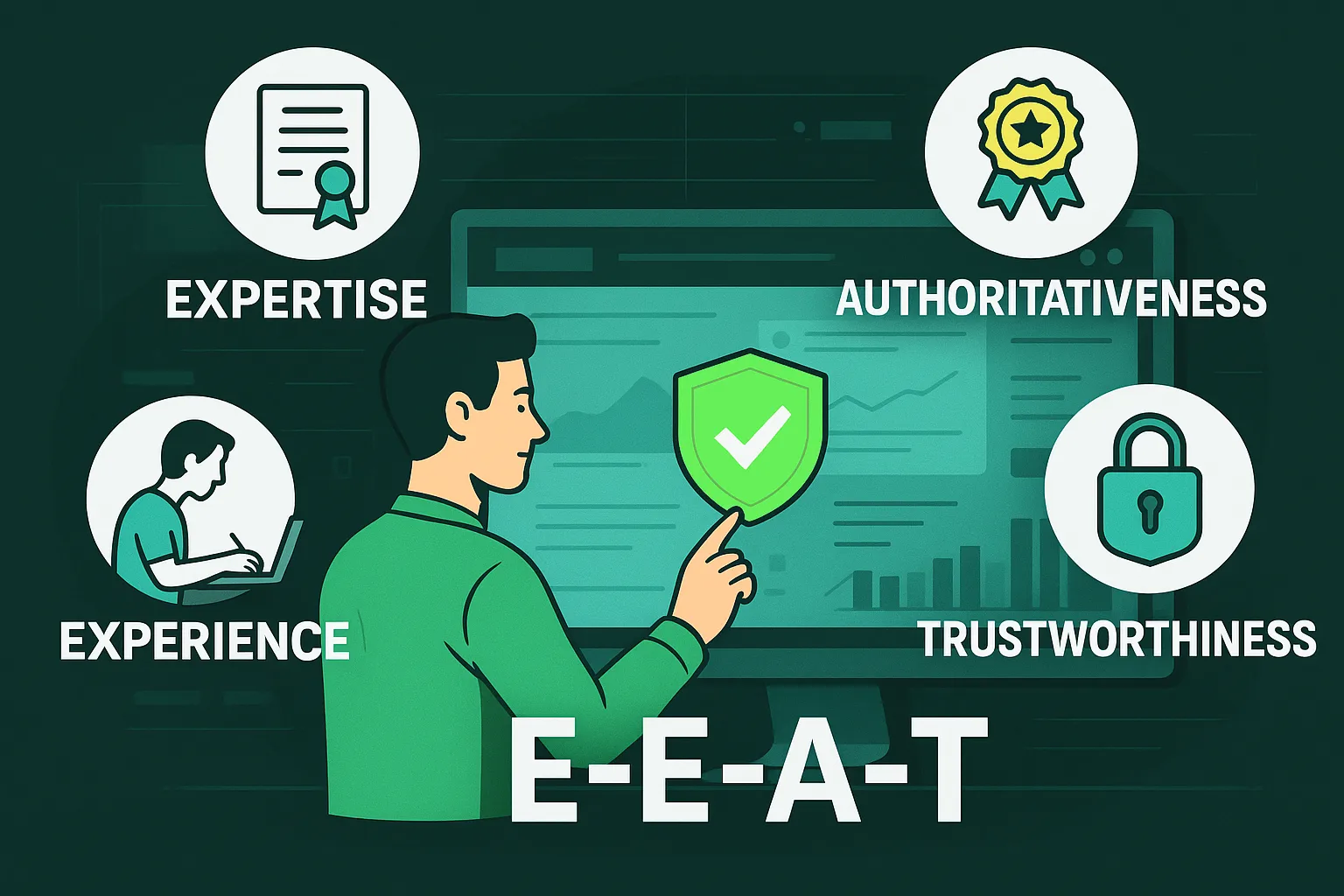Ranking on Google today is about much more than just using the right keywords. It’s about building a strong reputation and proving you’re a trustworthy source in your field. That’s where Google’s concept of E-E-A-T comes in — a key pillar that defines a website’s quality and credibility.
But what exactly is E-E-A-T, and how can you apply it to your business, whether you sell software, offer financial consulting, run a dental clinic, or manage an online store?
In this comprehensive guide, we break down each component of E-E-A-T and provide you with actionable strategies and real-life examples to help you strengthen your brand’s authority and boost your rankings on Google — no matter your niche.
What Does E-E-A-T Really Mean? A Breakdown
E-E-A-T is Google’s acronym for evaluating content quality based on four core elements: Experience, Expertise, Authoritativeness, and Trustworthiness.
- Experience: Refers to first-hand, practical knowledge. Has the author actually used the product they’re reviewing? Has the travel blogger visited the places they write about? Google wants to see evidence of real-world experience.
- Expertise: Involves formal and expert knowledge of a topic. This is especially important in YMYL (Your Money or Your Life) fields like health, finance, or law. It’s demonstrated through certifications, education, and a solid track record.
- Authoritativeness: Built when other experts or influential websites in your field recognize you as a reliable source. This comes through mentions, quality backlinks, reviews, awards, and more.
- Trustworthiness: The foundation that holds everything together. A trustworthy website is transparent, secure (HTTPS), honest, and user-first. Clear contact info, privacy policies, and easy return processes are key trust signals.
Practical Guide: How to Apply E-E-A-T to Your Business (With Real Examples)
Applying E-E-A-T isn’t about following a rigid formula. It’s about adopting best practices tailored to your specific industry. Here’s how:
1. How to Demonstrate EXPERIENCE and EXPERTISE
Your goal is to show that you know what you’re talking about — whether through training or real-world experience.
- Create detailed author bios: Don’t just add a name. Explain who’s behind the content.
- Example – Physical therapy clinic: Each therapist’s profile should include their degree, specializations (e.g., sports, neurology), years of experience, and license.
- Example – Speciality coffee e-commerce: The “About Us” page should tell the founder’s story, their trips to coffee farms, certifications as a taster, and passion for coffee.
- Publish case studies and real results: Social proof is your best ally.
- Example – Financial consulting firm: Share a detailed (anonymous) story about how you helped a family plan for retirement, outlining each step of the strategy.
- Example – Auto repair shop: Post a blog with before-and-after photos of a complex repair and explain the process.
- Show your credentials and certifications: Make them visible throughout your site.
- Example – Law firm: Include badges from legal associations, industry awards, and certifications in specialized areas.
- Example – Sports supplements store: Display quality seals, third-party lab test results, and approvals from health authorities.
2. How to Build AUTHORITATIVENESS
Your goal is to be recognised as a leader in your field.
- Get quality backlinks and mentions: Authority is earned and transferred.
- Example – Tech startup: Getting mentioned in niche media like TechCrunch or Wired is a massive authority signal.
- Example – Local restaurant: A great review in the local paper, strong social media presence, a respected food guide, or a foodie blog can establish local authority.
- Encourage reviews and testimonials: Let your customers speak for you.
- Example – Fashion e-commerce store: Use review platforms like Trustpilot and feature customer reviews with photos.
- Example – SaaS company: Display client logos and include video testimonials from key users or company leaders.
3. How to Generate TRUST
Trust is the foundation of any long-term business relationship.
- Be fully transparent: Be clear and upfront.
- All businesses: Your “Contact” page should be easy to find and include your physical address (if applicable), phone number, and email. For Google, a business with real-world visibility is more trustworthy.
- Example – Health blog: Add a disclaimer that the content is for informational purposes only and does not replace professional medical advice.
- Clear and accessible policies: Don’t hide the fine print.
- Example – Online store: Make your shipping, return, and warranty policies easy to find and understand. One click access reduces buyer anxiety and builds confidence.
- Security and trustworthy sources: Protect your users and support your claims.
- All websites: Make sure your site has an active SSL certificate (HTTPS). It’s a basic trust signal for users and for Google.
- Example – Investment blog: When sharing data or advice, always link to reputable sources: market reports, financial studies, or well-known news sites.
Trust Checklist for Your Website
TECHNICAL SECURITY
- SSL certificate (HTTPS) is active.
- Logins, forms, and payment pages are encrypted.
- No security warnings or blocked content.
- No aggressive pop-ups or suspicious redirects.
CONTACT INFORMATION
- Contact page is visible and easy to access.
- Professional email address (not Gmail, Yahoo, etc.).
- Includes phone number and physical address if applicable
- Registered on Google Business Profile.
CLEAR LEGAL POLICIES
- Your site includes:
- Privacy policy
- Legal notice (with business info if needed)
- Cookie policy (with banner and preferences).
- Terms and conditions
- All policies are updated, easy to read, and linked in the footer
FOR E-COMMERCE SITES
- Detailed:
- Shipping policies
- Returns and refunds
- Product warranties
- Order tracking and customer support.
- Secure payment methods (Visa, PayPal, Stripe, etc.).
TEAM & BRAND TRANSPARENCY
- “About Us” page with real company/team info.
- Real names, photos, and professional profiles (e.g., LinkedIn).
- Certifications, awards, or trust badges on display.
REPUTATION & CREDIBILITY
- Authentic customer reviews (not fake).
- Ratings from verified sources like Google or Trustpilot.
- Public, professional responses to negative feedback.
- Featured in media, blogs, or relevant directories.
What Are the Red Flags That Signal a Lack of Trust?
- Suspicious domain name or one that doesn’t match the brand
- Excessive caps, misleading statements, or aggressive CTAs
- Outlandish claims without evidence (“Lose 20 pounds in 5 days”, “Risk-free investing”)
- No clear authorship or editorial context
In Summary: E-E-A-T Is Your Long-Term Business Strategy
As you can see, optimizing for E-E-A-T goes far beyond technical SEO. It’s a business mindset that puts quality, transparency, and user experience at the heart of everything you do.
Whether you’re a local artisan, B2B consultant, or healthcare provider — building a brand that both your users and Google can trust is the most valuable and sustainable investment in your digital future.
Want to know where your site stands on the E-E-A-T scale? Contact us and we’ll run a full audit to uncover your strengths and highlight opportunities to help you earn your customers’ — and Google’s — trust.







